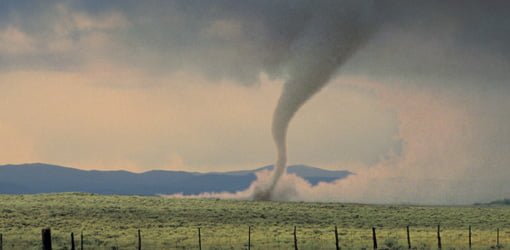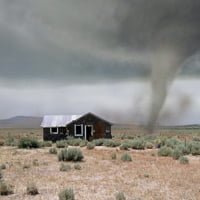
Tornadoes are one of the most destructive weather events, with winds as high as over 200 miles per hour and leaving a trail of destruction a mile or more wide. Around 1,000 tornadoes form in the U.S. each year; and while most occur in the spring or summer, they have been known to happen at any time of year.
If you live in an area where tornadoes are common, consider building a concrete reinforced safe room in the center of your home or an underground storm cellar. The next best place of refuge in a storm is in a basement, followed by an interior room without windows.

Automobiles and mobile homes are the worst places to be during a tornado, so get out and seek shelter in either a building or a low spot or ditch.
Keep a weather radio set to broadcast alerts when tornadoes are likely, and take shelter immediately. Do not attempt to open windows before a tornado, as it doesn’t prevent damage and may result in injuries from flying glass and debris.
After the severe weather has passed, check on neighbors, but be careful to avoid downed power lines and ruptured gas lines.
Tornado Emergency Supplies
A tornado can strike with very little warning, so it’s important to keep a supply of the items below stored in a storm resistant location for use in the aftermath of a storm.
- Food and Water: Drinking water and nonperishable food may be in short supply after a major tornado outbreak. Rotate food items periodically, checking the expiration date to make sure they’re fresh, and be sure to have a manual can opener on hand.
- Lighting: Be sure to keep several flashlights and extra batteries stored in your storm kit. Portable lamps that run on batteries are also available. Avoid using candles, since they are common for fires after a storm.
- Fuel: Keep a portable propane tank and gas can full and stored in a secure location away from your home.
- Radio: A battery-powered weather radio is the best way to stay informed during a tornado warning. A battery powered AM/FM radio is a good source of information after the storm has passed.
- Medical Supplies: Keep a first aid kit stored in your storm shelter, basement, or safe room, and take any prescription medications with you to the shelter during a storm.
- Cash: Keep cash on hand or stored in your storm shelter for use after a tornado when the power is off.
- Roof Repairs: Store tarps, plastic sheeting, felt nails, and duct tape in your storm shelter to use in making roof repairs after a tornado has passed.
- Tools: Keep a toolbox of basic hand tools (hammer, screwdriver, pliers, handsaw, a utility knife) in your storm shelter for use after the storm.
- Generator: A portable generator can provide emergency power after a tornado, but be sure to operate it in the open and at a safe distance from the home. Generators should not be used in an enclosed building, garage, carport, or near open windows or doors. Follow all instructions when using a generator, and don’t try to provide more power than the generator can supply.
- Insurance Records: Keep copies of insurance policies and a home inventory in a safe location such as a safe deposit box, or a safe in a storm resistant location.
Read more at https://www.todayshomeowner.com/how-to-prepare-for-a-tornado/

